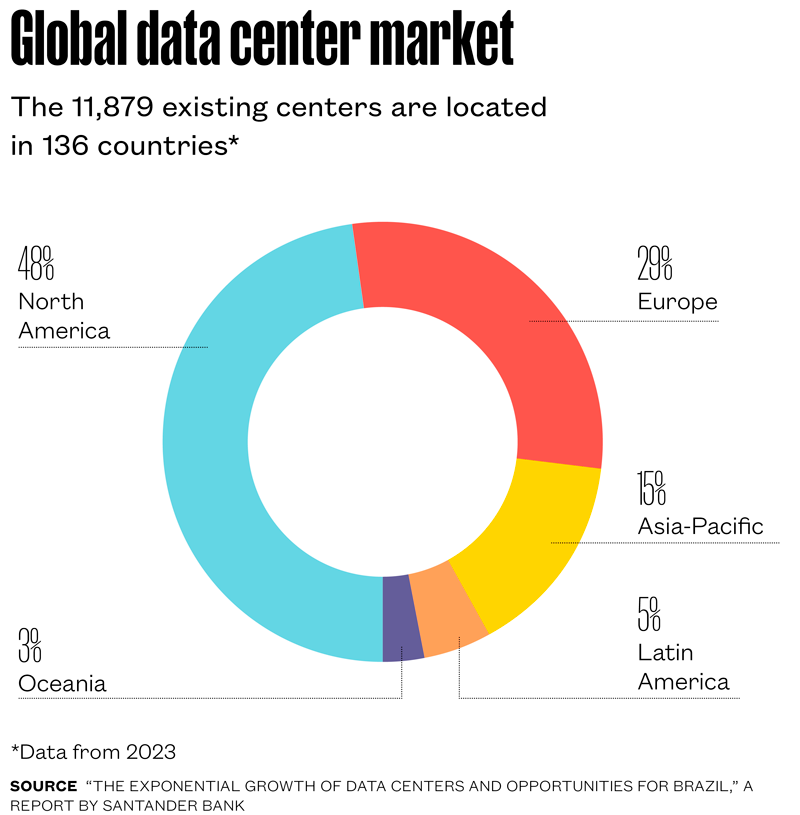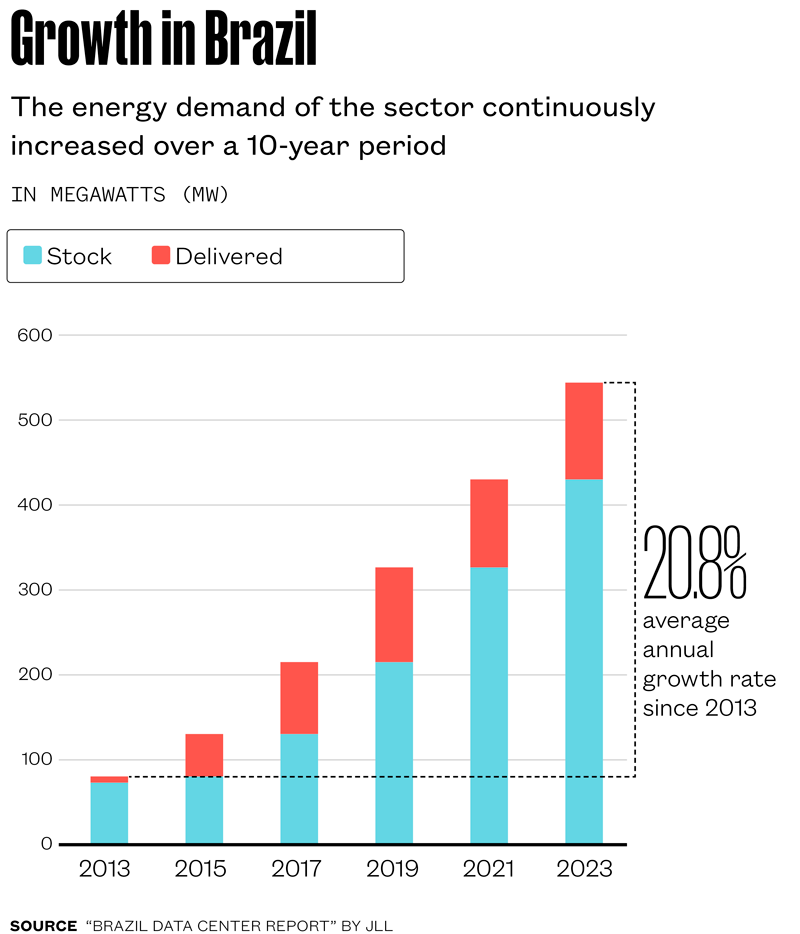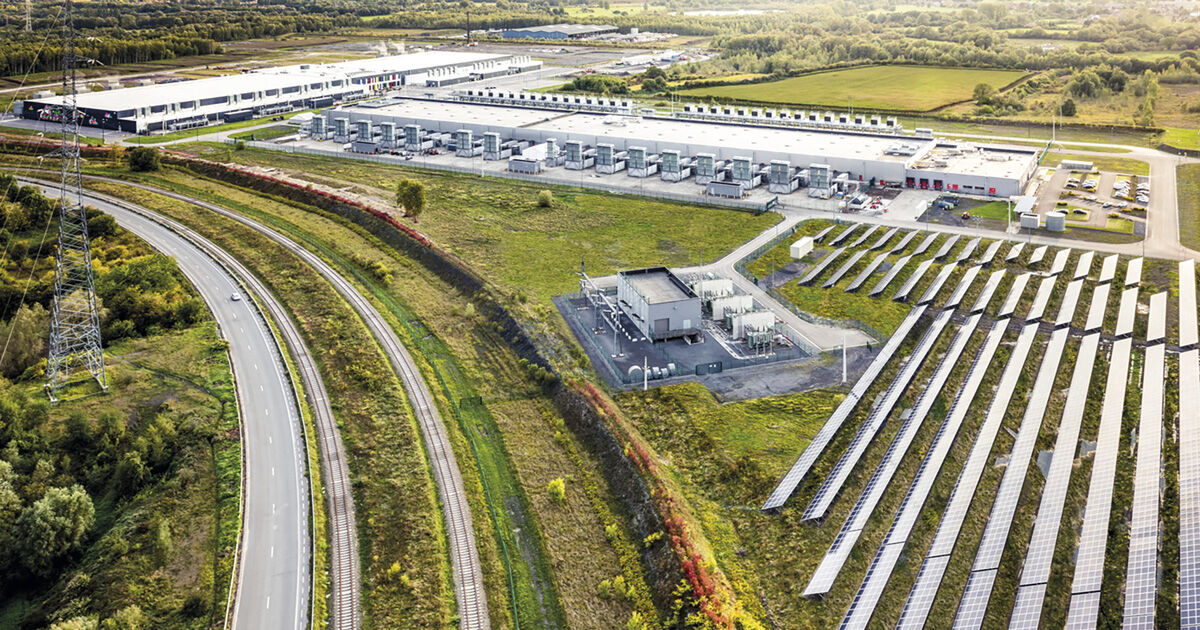Global demand for data centers, the backbone of the digital world, is increasing rapidly, driven by the explosion of artificial intelligence. At the end of 2023, there were more than 11,800 data centers around the world. The market is also growing in Brazil, largely concentrated in the state of São Paulo. Estimates suggest that cloud computing data centers account for 1% of global electricity demand.
One way to increase energy efficiency at data centers is to equip them with their own renewable energy infrastructure, such as solar panels or wind turbines, suggests computer scientist Daniel Cordeiro of the School of Arts, Sciences, and Humanities at the University of São Paulo (EACH-USP). With funding from FAPESP, his group is studying how computer resource management at data centers can reduce the industry’s carbon footprint.
Large multinationals in the sector are increasingly incorporating clean energy into their operations. In Google’s 2023 sustainability report, the company stated that 64% of the energy used at its data centers came from green sources, with some locations reaching 90%, while 75% of its carbon footprint was from indirect emissions, such as from the manufacturing of equipment. Microsoft also reported that 96% of the carbon footprint from its data centers is from indirect emissions.
One challenge when establishing renewable energy sources for data centers is their intermittent nature. “Solar panels only generate electricity during the day, when sun is shining, while wind turbines rely on ideal wind speeds. Energy storage devices are therefore needed, such as batteries, which themselves have an environmental cost,” explains information systems specialist Miguel Felipe Silva Vasconcelos. Currently a postdoctoral fellow at the Toulouse Institute for Research in Computer Science (IRIT), France, Vasconcelos is investigating the sustainability of distributed computing systems, which are composed of multiple elements—such as computers, cell phones, and sensors—that interact with each other to perform certain tasks.
 Alexandre Affonso / Revista Pesquisa FAPESP
Alexandre Affonso / Revista Pesquisa FAPESP
He began studying the subject during his PhD, co-supervised by Cordeiro and Fanny Dufossé, from Grenoble Alpes University, France, with funding from FAPESP. “I researched how to reduce the carbon emissions of a set of geodistributed cloud computing data centers through the adoption of local renewable energy infrastructure and sizing strategies,” he say.
Sizing, in this instance, means defining at which data center and at what time of day the required computational tasks are executed, with the aim of minimizing the consumption of energy that generates high carbon emissions. Cloud computing data centers are in high demand because they host the most important digital services and applications used on a day-to-day basis.
The study by Vasconcelos, presented at the 23rd International Symposium on Cluster, Cloud, and Internet Computing, held in Bangalore, India, in 2023, looked at nine data centers in different cities, including São Paulo, Paris, and Canberra, Australia—none, coincidentally, that house Microsoft facilities.
The researcher evaluated the characteristics of each location to determine the solar panel area and battery storage. He considered solar radiation throughout the year, the energy needed to cool servers, and the carbon footprint of the local electricity grid and the manufacturing process of the solar panels and batteries.
“Our work resulted in a mathematical model that can be used to determine the optimal sizing of the renewable energy generation and storage infrastructure at a data center,” says Cordeiro. “A cloud computing platform manager who wants to assess the energy infrastructure needed for their data centers can use our software, which implements this model, to analyze different investment scenarios and their respective environmental impacts.”
 Alexandre Affonso / Revista Pesquisa FAPESP
Alexandre Affonso / Revista Pesquisa FAPESP
As home to 1.5% of the global market with 181 data centers, Brazil has proven to be an attractive country for the sector. The market in Brazil grew by 628% between 2013 and 2023, according to the “Brazil data center report” by real estate consultancy JLL. “It is important to invest in data centers to ensure our digital sovereignty, which includes control over digital assets, such as data, software, hardware, and infrastructure,” explains Cordeiro.
Several projects are already underway, including three new Microsoft data centers in the Campinas region. The first is set to be completed this year. In September 2024, Amazon, which already has operations in Brazil, announced plans to invest R$10 billion to expand its data center infrastructure in the country over the following ten years.
“Countries with a green energy mix or favorable conditions for renewable energy generation, like Brazil, are attracting major players in the cloud computing sector who are committed to reducing CO₂ [carbon dioxide] emissions by using greener energy sources,” says Vasconcelos.
However, experts say that even if the country’s energy mix is strongly based on renewable sources, the construction of data centers still affects the environment—after all, the construction of hydroelectric dams is not free of impact and data centers will always consume a high volume of water and emit high levels of carbon, whether directly or indirectly.
“The discussion about environmental sustainability is relevant whenever we are building infrastructure to support some type of industry in the country,” says Cordeiro, who emphasizes that if major computing platform providers produce their own energy from renewable sources, data centers can operate more sustainably.
The story above was published with the title “Sustainable data centers” in issue in issue 349 of march/2025.
Projects
Applications of scheduling theory to optimize the use of green energy in cloud computing platforms (nº 21/06867-2); Grant Mechanism Research Grant; Principal Investigator Daniel de Angelis Cordeiro (USP); Investment R$73,394.59.
Scientific articles
CORDEIRO, D et. al. Green cloud computing: Challenges and opportunities. Anais Estendidos do XIX Simpósio Brasileiro de Sistemas de Informação (SBSI 2,023). May 20, 2023.
VASCONCELOS, M. et al. Optimal sizing of a globally distributed low carbon cloud federation. 2023 IEEE/ACM 23rd International Symposium on Cluster, Cloud and Internet Computing (CCGrid). pp. 203–15. 2023.
VASCONCELOS, M. et al. Indirect network impact on the energy consumption in multi-clouds for follow-the-renewables approaches. Proceedings of the 11th International Conference on Smart Cities and Green ICT Systems SMARTGREENS. Vol. 1, pp. 44–55. 2022.
Reports
Brazil Data Center Report: Brazil main markets outlook 2023. JLL. Jan. 2024
Powering Intelligence: Analyzing artificial intelligence and data center energy consumption. Electric Power Research Institute (EPRI). 2024.

